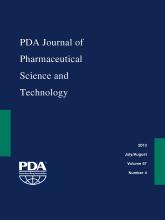Abstract
In January 2011, the U.S. Food and Drug Administration published new process validation guidance for pharmaceutical processes. The new guidance debunks the long-held industry notion that three consecutive validation batches or runs are all that are required to demonstrate that a process is operating in a validated state. Instead, the new guidance now emphasizes that the level of monitoring and testing performed during process performance qualification (PPQ) studies must be sufficient to demonstrate statistical confidence both within and between batches. In some cases, three qualification runs may not be enough. Nearly two years after the guidance was first published, little has been written defining a statistical methodology for determining the number of samples and qualification runs required to satisfy Stage 2 requirements of the new guidance. This article proposes using a combination of risk assessment, control charting, and capability statistics to define the monitoring and testing scheme required to show that a pharmaceutical batch process is operating in a validated state. In this methodology, an assessment of process risk is performed through application of a process failure mode, effects, and criticality analysis (PFMECA). The output of PFMECA is used to select appropriate levels of statistical confidence and coverage which, in turn, are used in capability calculations to determine when significant Stage 2 (PPQ) milestones have been met. The achievement of Stage 2 milestones signals the release of batches for commercial distribution and the reduction of monitoring and testing to commercial production levels. Individuals, moving range, and range/sigma charts are used in conjunction with capability statistics to demonstrate that the commercial process is operating in a state of statistical control.
LAY ABSTRACT: The new process validation guidance published by the U.S. Food and Drug Administration in January of 2011 indicates that the number of process validation batches or runs required to demonstrate that a pharmaceutical process is operating in a validated state should be based on sound statistical principles. The old rule of “three consecutive batches and you're done” is no longer sufficient. The guidance, however, does not provide any specific methodology for determining the number of runs required, and little has been published to augment this shortcoming. The paper titled “Risk-based Methodology for Validation of Pharmaceutical Batch Processes” describes a statistically sound methodology for determining when a statistically valid number of validation runs has been acquired based on risk assessment and calculation of process capability.
- Process capability
- Statistical confidence
- Statistical coverage
- Control chart
- PFMECA
- Process validation
- Risk-based.
- © PDA, Inc. 2013
PDA members receive access to all articles published in the current year and previous volume year. Institutional subscribers received access to all content. Log in below to receive access to this article if you are either of these.
If you are neither or you are a PDA member trying to access an article outside of your membership license, then you must purchase access to this article (below). If you do not have a username or password for JPST, you will be required to create an account prior to purchasing.
Full issue PDFs are for PDA members only.
Note to pda.org users
The PDA and PDA bookstore websites (www.pda.org and www.pda.org/bookstore) are separate websites from the PDA JPST website. When you first join PDA, your initial UserID and Password are sent to HighWirePress to create your PDA JPST account. Subsequent UserrID and Password changes required at the PDA websites will not pass on to PDA JPST and vice versa. If you forget your PDA JPST UserID and/or Password, you can request help to retrieve UserID and reset Password below.






